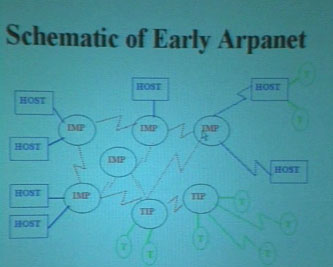The ARPANET

Video: MPEG-1 file (18MB)
Prof. Peter Kirstein describes the revolutionary architecture of the Arpanet (in English)
The backbone of the ARPANET consisted of packet-switching computers, called IMPs (Interface Message Processors), connected by, for the time, superfast 56 Kbit/s lines. Conventional computers with appropriate communications software were then connected to these IMP nodes.
In the autumn of 1969 the first ARPANET computer was connected to the ARPANET's IMP node at the University of California at Los Angeles (UCLA). Doug Engelbart's hypertext-project computer at Stanford Research Institute (SRI) was the next. By the end of the year, the network also included the computers at the University of California, Santa Barbara (UCSB) and the University of Utah, i.e. four in all. All the computers used different operating systems and they were able to talk to each other across the network with equal status. Some years later, RFC1000 tells the story of these days of the birth of the Internet, in which enthusiastic students played an important part.
During the 1970s, the ARPANET grew to connect research institutes and laboratories supported by the Department of Defense in various parts of the USA. Many of these were university laboratories studying data processing and computer networks, which developed the TCP/IP network and its applications for the Internet.
In 1980 IP became the official standard of the US Department of Defense, and the original ARPANET adopted IP on 1.1.1983, when it became a major part of the Internet. At this time, Defense Department computers were separated from the ARPANET to form their own MILNET network. In 1986 the NSFNET constructs its own backbone network to run in parallel to the ARPANET. And, finally in 1990, with everyone having gone over to using the newer, faster Internet backbone network, the original ARPANET with its network address 10.0.0.0 was shut down.